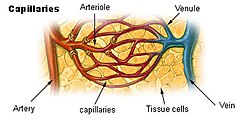AY Honors/Heart and Circulation/Answer Key
1. Describe the basic function of the following parts of the circulatory system: heart, blood vessels, blood, and lungs.
2. Describe the major difference between arteries and veins. What is a capillary and what is its function?
Arteries are muscular blood vessels that carry blood away from the heart. All arteries, with the exception of the pulmonary and umbilical arteries, carry oxygenated blood.
Veins are blood vessels that carry blood toward the heart. The majority of veins in the body carry low-oxygen blood from the tissues back to the heart; the exceptions being the pulmonary and umbilical veins which both carry oxygenated blood.
Capillaries are the smallest of a body's blood vessels, measuring 5-10 μm, and are important for the interchange of oxygen, carbon dioxide, and other substances between blood and tissue cells. The walls of capillaries are composed of only a single layer of cells, the endothelium. This layer is so thin that molecules such as oxygen, water and lipids can pass through them by diffusion and enter the tissues. Waste products such as carbon dioxide and urea can diffuse back into the blood to be carried away for removal from the body. Capillaries are so small the blood cells need to pass through it in a single file line. Capillaries carry blood from the arteries to the veins.

